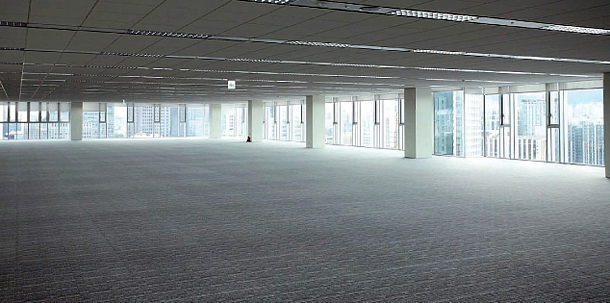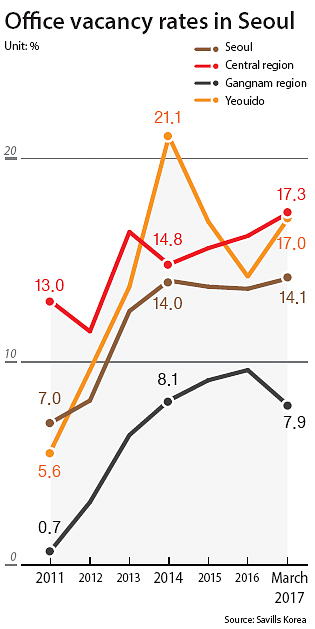In central Seoul, empty space

An office space at a building in central Seoul remains empty in this photo taken recently. In this region, one in six offices is vacant. [JOONGANG ILBO]
In Seoul, there are many regions like this. The central regions like Jongno and Jung Districts and Yeouido are facing this situation.
Local construction giant Booyoung Group acquired Samsung Life Insurance’s headquarters in central Seoul, last year. But the vacancy rate of the building now more than 70 percent. It has been more than six months since Samsung Life Insurance moved to the Samsung’s headquarters in Seocho, southern Seoul, but the vacancy rate issues there haven’t been solved.
“I don’t know if we will be able to fill the offices since there are many newly constructed building in the neighborhood,” said a representative at a real estate firm near the building.

In central Seoul, the rate rose 1.1 percentage points from the previous quarter to 17.3 percent and in Yeouido rose 2.8 percentage points to 17 percent. This means that one out of six offices in these regions is empty. Meanwhile, the vacancy rate in the Gangnam region in southern Seoul dropped 1.7 percentage points from the previous quarter to 7.9 percent.
The biggest reason for the high vacancy rate is the many newly constructed office buildings in Seoul. Even though demand for offices dropped significantly after the global financial crisis in 2008, many construction firms started projects to redevelop towns by demolishing old buildings and build new ones starting three to four years ago.
Many firms believed that they would attract rents from new buildings since the demand was high when they started projects. Those properties are now on the market, but the situation has changed.
“The supply of buildings is exceeding demand in central Seoul due to the many reconstruction projects,” said Yoo Myung-han, a researcher at Colliers International Korea.
Furthermore, the number of people looking for property has declined. The giant renters like large companies are moving from central Seoul and Yeouido to other regions. Samsung Life Insurance and Samsung Fire & Marine Insurance moved to the Samsung headquarters in Seocho-dong, southern Seoul, last year. Securities firms like Daishin Securities Mirae Asset Daewoo also left Yeouido. Many are relocating to reduce costs.
Landlords have raised rent prices, claiming their buildings are brand-new.
According to Korea Appraisal Board, rent prices in central Seoul rose 15 percent year on year to 93,000 won ($81) per 3.3 square meters. Fewer people are starting businesses due to the sluggish economy and those who do so try to avoid offices in central Seoul nowadays.
“Start-ups prefer Gangnam over central Seoul,” said Yoo.
As the vacancy rate continues to rise, the rate of return for investors is also falling. Korea Appraisal Board data showed the rate of return for people who invested in office construction dropped 0.12 percentage points from a year ago to 1.66 percent in the first quarter of this year.
The current trend is expected to continue for some time. Savills Korea predicted about 57,000 square meters in big office buildings will be on the market this year. This will be the biggest number since 2010, and is 400 percent more than 140,000 square meters on the market last year, the company said.
According to Cushman & Wakefield, the expected vacancy rate in central Seoul continues to rise. It is expected that there will be more empty buildings and it will eventually lower rent fees.
Some disagree. “The vacancy rate in Yeouido will remain high as there are many supplies while many companies are moving away,” said Kim Jung-eun, a spokesperson at Savills Korea. “But central Seoul is very popular among companies so I don’t think the rate will go up rapidly.”
BY HWANG EUI-YOUNG [kim.youngnam@joongang.co.kr]










with the Korea JoongAng Daily
To write comments, please log in to one of the accounts.
Standards Board Policy (0/250자)